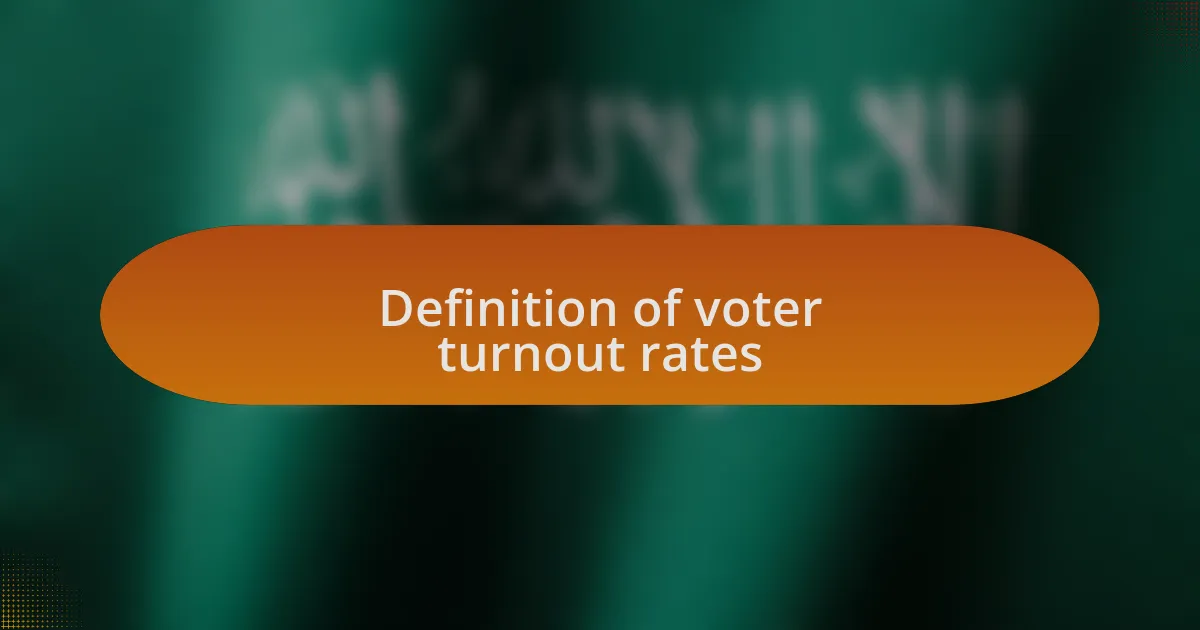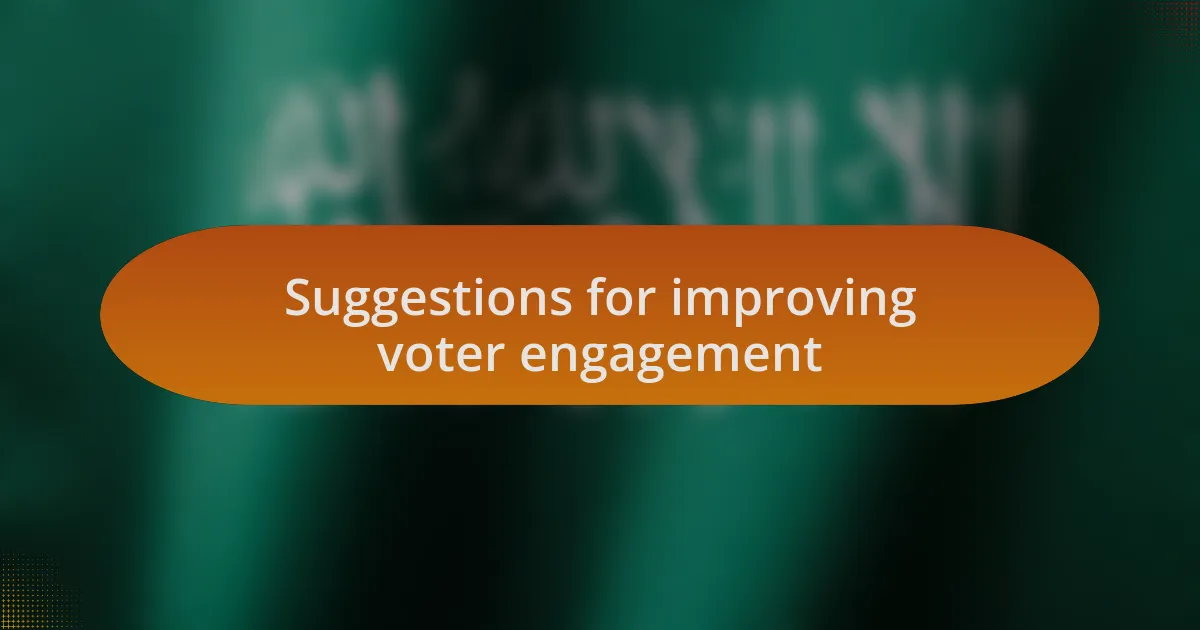Key takeaways:
- Voter turnout rates reflect civic engagement and impact the health of democracy; higher turnout indicates a politically involved population.
- Accessibility, community engagement, and information availability significantly influence voter participation.
- Political media platforms can empower voters by providing accessible information and fostering community through social interaction.
- Improving voter engagement can be achieved through local events, gamified learning, and the use of relatable storytelling in outreach campaigns.

Definition of voter turnout rates
Voter turnout rates refer to the percentage of eligible voters who actually cast their ballots in an election. This measure reflects civic engagement and the public’s interest in participating in the democratic process. I remember the excitement I felt walking into my polling place for the first time; it was a tangible way of exercising my voice.
Interestingly, voter turnout can vary significantly from one election to another. For instance, midterm elections often see lower turnout compared to presidential elections. I sometimes wonder why that is: is it because people feel less invested in these elections, or do they simply not understand their impact?
When we analyze voter turnout rates, we can gauge the overall health of a democracy. High turnout can indicate a politically engaged population, while low turnout might raise concerns about accessibility and public interest. Reflecting on my personal experiences, I noticed that in elections where outreach and education campaigns were strong, I saw more of my friends getting involved. What do you think influences your friends to vote?

Importance of voter turnout
Voter turnout is crucial because it signifies the level of public interest in governance and policy-making. I vividly recall a local election that showcased how a small group of dedicated voters could sway the outcome, emphasizing that each vote truly matters. When turnout is high, it reflects a collective enthusiasm for shaping the community’s future, which is empowering for all involved.
I think about how my own perspective on voting has evolved over time. Early in my voting journey, I viewed it as a duty, but I’ve come to see it as an opportunity to express my beliefs and influence change. When people show up to vote, they’re not just filling a void; they are voicing their concerns and hopes for their communities, something I believe is foundational to democracy.
Moreover, high voter turnout can lead to better representation and more responsive governance. I often hear my friends discuss how they want politicians to cater to their needs, yet many don’t engage in the very process that enables change. Isn’t it ironic that we often speak about wanting a voice without using the power we have in our hands? Every election is a chance to align our leaders with the community’s values, reinforcing the importance of each individual’s participation.

Factors influencing voter turnout
When I reflect on the factors that influence voter turnout, I can’t help but think about accessibility. For instance, I once volunteered at a polling station and noticed how crucial it was for certain voters to have rides arranged or even assistance navigating the voting process. It struck me that when barriers like long lines, complicated registration, or transportation issues are in the way, they can dampen people’s enthusiasm to participate. After all, how many potential voters are deterred just by logistics?
Another significant aspect is the sense of community engagement. I recall the overwhelming energy at a town hall meeting I attended before a major election. It was inspiring to see neighbors discussing issues that directly impacted our lives. This type of interaction fosters a feeling of responsibility to show up on election day. If people feel connected to the issues and to each other, they’re more likely to make the effort to cast their ballots. Isn’t it fascinating how much our social circles can influence our voting habits?
Finally, I can’t ignore the role of information in driving turnout. I remember spending hours researching candidates and propositions before an election—what a difference understanding the stakes made for me! When people are informed and understand how their vote can influence matters that affect their daily lives, they’re more inclined to participate. I often wonder, what would happen if more people actively sought out information? Would we see a shift in turnout rates, and consequently, in representation?

Role of political media platforms
Political media platforms play a crucial role in shaping voter perceptions and, ultimately, turnout rates. I still remember the podcast I listened to before an election, which broke down complex policy issues into bite-sized information. It made me realize how accessible content can empower voters, making them feel more confident in their ability to engage with the political process. Isn’t it remarkable how a simple discussion can spark a desire to vote?
Moreover, these platforms foster a sense of community and urgency. I think back to a Twitter thread that went viral, encouraging people to share their voting plans. The collective excitement was palpable, and I found myself motivated to confirm my own plans. It’s astounding how a shared moment online can translate into real-world action. Don’t you think social media can often act as a rallying point for potential voters?
In addition, the influence of political media platforms extends to combating misinformation. I once encountered a misleading article about voting regulations that had me worried. However, a quick fact-check through a trusted source allowed me to see the truth. This experience highlighted for me how critical reliable information is to circumvent confusion and encourage turnout. Isn’t it important for us to have platforms that not only engage but also protect the integrity of our electoral process?

Suggestions for improving voter engagement
One effective way to improve voter engagement is to host local events where community members can discuss the issues that matter most to them. I attended a town hall meeting once, and it was refreshing to hear people voice their concerns and ideas in person. Doesn’t it feel good to know that you have a say in shaping your community’s future? Such gatherings empower voters, as they cultivate a sense of belonging and purpose in the electoral process.
Another suggestion involves using gamified approaches to draw in younger voters. I recently came across an app that turned learning about candidates and their policies into a fun quiz game. It made the often-daunting task of researching candidates feel less like a chore and more like an interactive experience. Don’t you think engaging formats can resonate more with those who might otherwise feel disinterested in traditional political campaigning?
Finally, incorporating storytelling into voter outreach can make political issues more relatable and impactful. I’ve seen campaigns share personal stories from constituents that highlight how policies affect real lives. Hearing someone’s struggle or triumph can be a powerful motivator, making issues feel personal and urgent—don’t we all connect better when we understand the human experience behind statistics? By leveraging stories to break down barriers, organizations can foster deeper connections that inspire action.